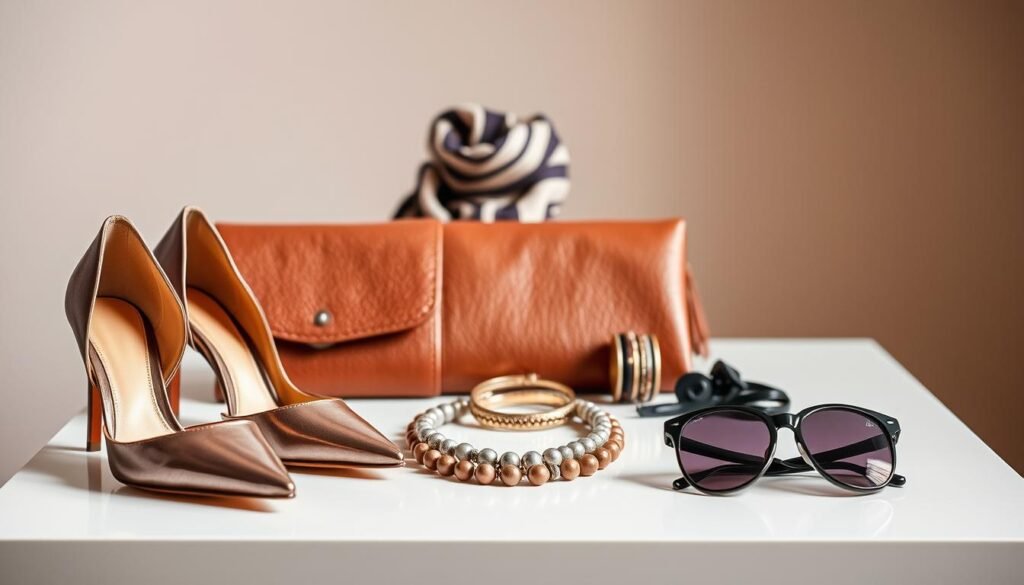“Fashion is not something that exists in dresses only. Fashion is in the sky, in the street, fashion has to do with ideas, the way we live, what is happening,” said Coco Chanel. This timeless wisdom perfectly captures why the right accessories can transform your entire look.
Your personal style doesn’t need a complete wardrobe overhaul. The secret lies in smart accessorizing that reflects who you are. Whether you’re building your first collection or refining your current pieces, the right approach makes all the difference.
Professional stylist Sian Clarke emphasizes that accessorizing is the most instant and cost-effective way to update your style. She recommends starting with one piece you already own or feel most comfortable with. This builds confidence naturally as you expand your collection.
This guide will change how you style. You’ll learn practical strategies for picking fashion accessories that fit your lifestyle and highlight your natural beauty.
Key Takeaways
- Start with one accessory you feel comfortable wearing to build confidence gradually
- Accessories offer the most cost-effective way to refresh your entire wardrobe instantly
- Understanding your personal style is key before buying new pieces
- Quality over quantity creates a more versatile and long-lasting collection
- Professional styling tips can help you choose accessories without feeling overwhelmed
- Smart investment decisions ensure your accessories complement your lifestyle
1. Understanding Your Personal Style Identity
Finding your true style is key before buying fashion accessories. Your style identity guides your choices. Without it, you might buy things that don’t fit your look or end up in the closet.
Stylists say knowing your style helps avoid bad buys and looks good together. It’s about looking at what you like, what makes you feel good, and what you always choose.
Identifying Your Style Preferences Through Self-Assessment
Begin by looking at your favorite clothes. Think about why you love them. Do you like simple designs or bold patterns?
Make a mood board with pictures of outfits you love. Look for colors, textures, and shapes. This shows if you like classic, bohemian, or modern styles.
Take pictures of yourself with different accessories. See which ones make you feel best. This shows your true style better than any quiz.
Analyzing Your Lifestyle and Daily Needs
Your daily life affects what accessories you need. Think about your job, social life, and what you like to wear. A corporate job needs different accessories than a creative job.
Make a list of your weekly activities and what you wear. Do you need versatile pieces for work and dinner? Or special accessories for certain events?
Also, think about the weather, how you get around, and what you do. Someone who walks a lot needs different accessories than someone who drives. Your lifestyle helps you choose accessories that fit your daily life.
2. Assessing Your Current Wardrobe Foundation
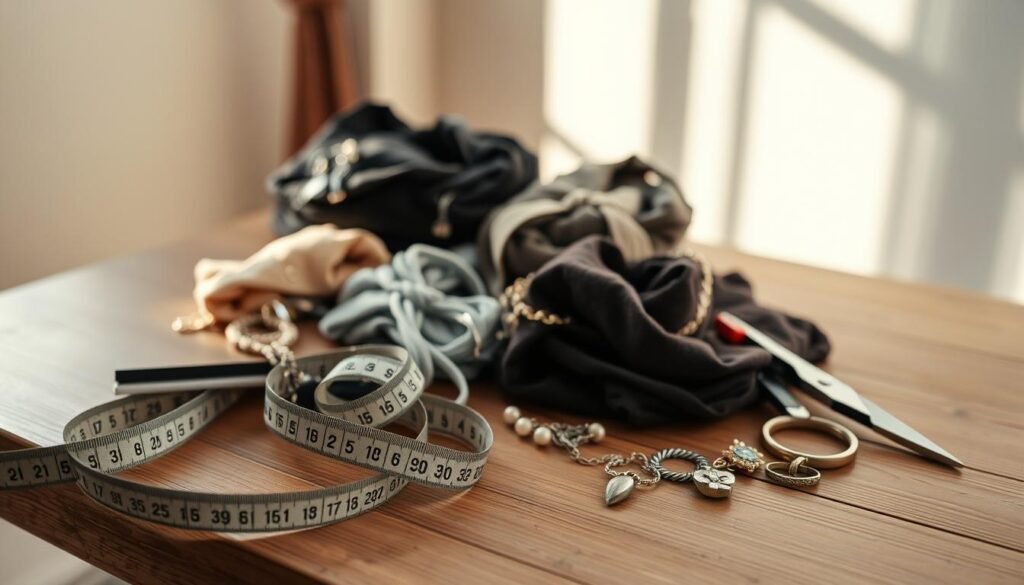
Knowing what you already own is key to making accessory recommendations that fit. Many rush into buying new accessories without thinking about how they match their current clothes. This can lead to spending a lot and ending up with items that never get paired.
Doing a thorough wardrobe check saves money and makes sure new buys improve your collection. You’ll find hidden favorites and see where new pieces can really make a difference.
Taking Complete Inventory of Existing Pieces
Begin by taking everything out of your closet and sorting it. Put items into piles for tops, bottoms, dresses, outerwear, and shoes. This makes it clear what you have.
Take photos of each group or list them on your phone. Note which items you wear most and which you hardly use. Styling experts say to focus on your favorites first, as they show your true style.
Look closely at pieces that seem missing something. That simple black dress might just need the right necklace to become your favorite. These are great chances to add accessories that make a big difference.
Remember to include items from other closets or drawers. A full inventory means everything you own, even if you haven’t worn it in a while.
Identifying Dominant Color Patterns and Themes
Find the colors that show up a lot in your clothes. Most people have three to five main colors, plus neutrals like black, white, navy, or beige. These colors should guide your accessory choices.
See if you prefer warm tones like reds and oranges, or cool tones like blues and purples. This affects which metals, stones, and colors will look best on you. Warm tones go well with gold, while cool tones match silver.
Look at the style themes in your favorite clothes. Are they classic and tailored, or bohemian and flowing? Knowing these patterns helps you pick accessories that really suit you.
Write down these color and style patterns in your phone or notebook. These tips will help you shop for accessories that match many outfits.
3. Essential Accessories Every Wardrobe Needs
Choosing the right accessories starts with finding the core pieces that fit any occasion. It’s important to invest in essential accessories that match your wardrobe. This guide focuses on timeless items that boost your style.
Experts say start with basics before adding trendy items. These basics are versatile and match many outfits. Remember, quality over quantity is key for a good accessory collection.
Must-Have Jewelry Pieces for Versatility
Every jewelry collection needs four key pieces to enhance any outfit. Stud earrings are a great starting point for beginners. They go well with both casual and formal looks.
Delicate chain necklaces are perfect for layering and look great alone. Simple bracelets add a unique touch to your wrists. Statement rings complete the set, letting you express your style through unique designs.
Functional Bags and Purses for Every Occasion
You need four types of bags for different needs. An over-the-shoulder bag is perfect for daily essentials and keeps your hands free.
A backpack is great for commuting and running errands. Elegant clutches are ideal for special events. Large structured bags hold work documents and family needs. These accessories keep you ready for anything.
Versatile Scarves and Statement Belts
Scarves can change a simple outfit into something stylish. Choose neutral colors that match many outfits.
Statement belts define your waist and add flair to loose clothes. Both are decorative and practical.
Quality Footwear and Watch Options
Invest in comfortable flats, versatile heels, and supportive sneakers for all occasions. Each shoe should fit your lifestyle and style.
A classic watch is a timeless choice that goes with any outfit. Pick designs that won’t go out of style soon.
| Accessory Category | Essential Pieces | Styling Versatility | Investment Priority |
|---|---|---|---|
| Jewelry | Earrings, Necklaces, Bracelets, Rings | High | Medium |
| Bags | Shoulder Bag, Backpack, Clutch, Work Bag | High | High |
| Fashion Accessories | Scarves, Statement Belts | Medium | Low |
| Footwear & Watches | Flats, Heels, Sneakers, Classic Watch | High | High |
4. Mastering Color Coordination and Pattern Mixing
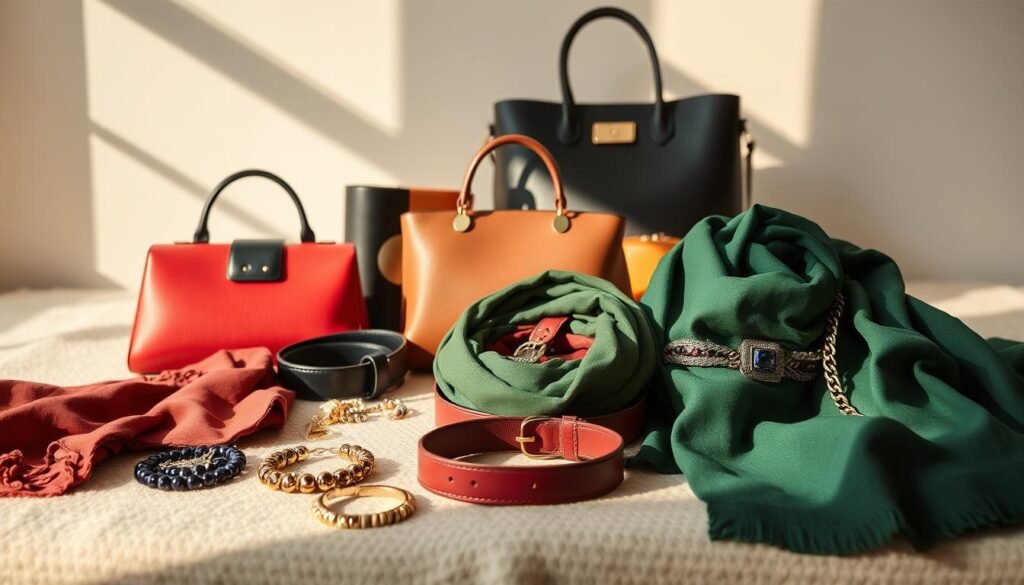
Knowing how colors work together is key to styling like a pro. It’s not about matching everything perfectly. It’s about picking colors that make you look good.
Balance is more important than matching. Mixing colors that go well together makes your look more interesting. For example, gold hoop earrings with an emerald necklace show how different things can look great together.
Understanding Basic Color Theory Principles
Color theory is the base of good styling. The color wheel shows which colors go well together. Complementary colors are opposite each other and create a strong contrast. Analogous colors are next to each other and offer a soft harmony.
Warm colors like reds and oranges add energy. Cool colors like blues and greens calm you down. Knowing this helps you pick accessories that match your outfit’s mood.
Creating Cohesive Color Palettes That Work
Start with a neutral color for your basics. This neutral color is your base for adding accent colors with accessories. Experts say to stick to three main colors and neutrals to keep your look simple.
The 60-30-10 rule is great for accessories. Use your main color for 60%, a secondary color for 30%, and bold colors for 10%. This keeps your look balanced, like matching ties with suits.
“The biggest mistake people make is trying to match everything exactly. True style comes from understanding how colors work together, not from making everything identical.”
Too much matching looks like a costume. Don’t wear green on green. Choose one or two pieces in your accent color and let them stand out against your neutral base.
5. Selecting Accessories for Different Occasions
Learning to pick the right accessories for each occasion can make your wardrobe more versatile. Each event calls for a unique set of fashion accessories. For example, your office look should differ from what you wear to brunch or a fancy dinner.
Knowing what works for each situation boosts your confidence. This accessories buying guide will help you understand what’s needed for different events. You’ll learn to pick items that show off your style while fitting the occasion.
Professional and Workplace Appropriate Choices
At work, your accessories should boost your professional look without being too much. A good watch is both useful and stylish. Opt for structured handbags that keep your essentials organized and look good.
For the office, go for classic jewelry like simple earrings, delicate necklaces, and minimal rings. These fashion accessories add to your business outfit without being too flashy.
Brogues can make casual clothes like jeans and a t-shirt look professional. They’re a smart choice for your work wardrobe because they’re versatile.
Casual and Weekend Styling Options
On weekends, you can express yourself with bold colors and textures. Try statement scarves, colorful handbags, and fun jewelry. These pieces let your personality shine when you’re not at work.
Play with different materials and patterns to create unique looks. Canvas totes, leather bracelets, and fun sunglasses can add personality to casual outfits. Feel free to mix things up and show off your style.
Formal and Evening Event Accessories
For formal events, you’ll want accessories that add glamour. Statement jewelry is perfect for these nights. Look for pieces with sparkle or unique details that catch the eye.
Clutch bags are great for events where you don’t need to carry much. Choose elegant shoes that match your dressier outfit but are also comfortable for a long night.
Travel and Vacation Practical Selections
Travel accessories need to be both stylish and practical. Pick pieces that go with many outfits in your luggage. Crossbody bags are handy for exploring because they’re secure and let you keep your hands free.
Opt for durable materials that can handle various activities. Comfortable shoes, lightweight scarves, and simple jewelry are good for travel. They keep your style on point while you’re on the move.
6. Quality vs Budget: Making Smart Investment Decisions
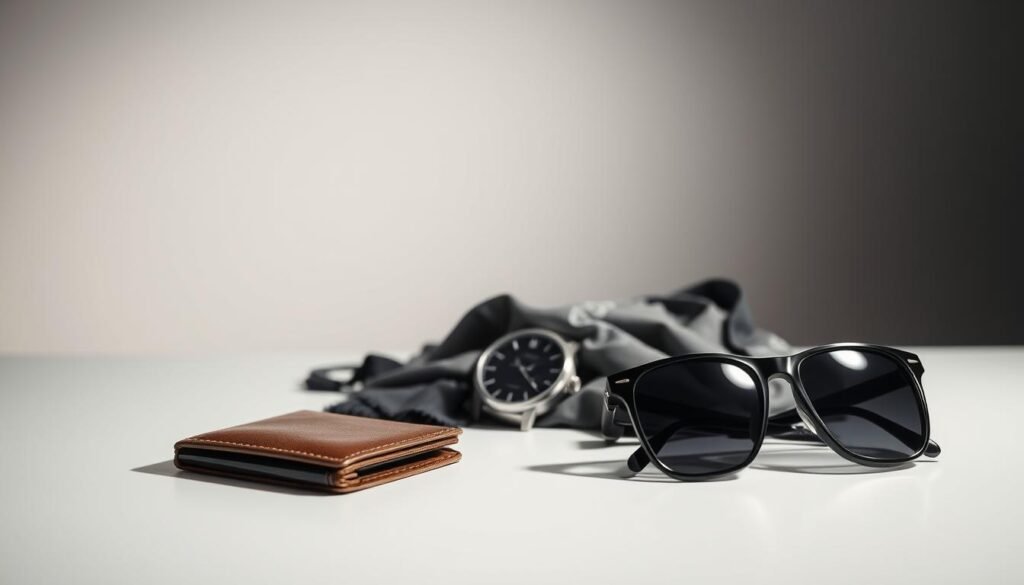
Knowing when to spend and when to save on accessories changes how you shop. It helps you make the most of your style budget. By balancing strategic balance between quality and affordable options, you can build a great accessory collection. These styling tips guide you to make choices that fit your style and budget.
Identifying Worth-the-Splurge Investment Pieces
Some accessories are worth spending more on because they last long and get better with time. A classic leather handbag from a well-known brand can last for decades. Quality watches become family treasures that keep their value or even increase it.
Shoes made from real leather get more comfortable and stylish as you wear them. Timeless jewelry pieces in gold or silver don’t tarnish or break easily. These accessory recommendations are for items you’ll use a lot over different seasons and events.
Investment pieces are made with top materials and designs that stay in style. Look for strong stitching, quality hardware, and brands known for their craftsmanship. The cost per wear is low when you use them for years.
Finding Quality Budget-Friendly Alternatives
For those watching their budget, there are great options through sustainable shopping practices and small brands. Pre-loved shops and consignment stores sell designer items at lower prices. Many items are barely used, giving you access to luxury brands without the high cost.
Independent designers offer unique, well-made items similar to big brands. Supporting small businesses helps you create a distinctive personal style. Online and vintage shops also offer a wide range of choices.
Save money on trendy or unique items, as fashion trends change. Affordable items like colorful scarves or bold earrings are perfect for seasonal use. These styling tips help you stay fashionable without spending too much on fleeting trends.
| Investment Category | Splurge-Worthy Items | Budget-Friendly Alternatives | Expected Lifespan |
|---|---|---|---|
| Handbags | Leather designer bags | Pre-loved luxury pieces | 10+ years vs 5+ years |
| Jewelry | Gold and silver pieces | Independent designer jewelry | Lifetime vs 3-5 years |
| Footwear | Quality leather shoes | Well-made synthetic options | 8+ years vs 2-3 years |
| Watches | Swiss or Japanese movements | Reliable fashion watches | 20+ years vs 3-5 years |
7. Seasonal Accessory Selection Strategies
Smart seasonal planning makes your fashion accessories both useful and stylish all year. Each season has its own weather and events that need special accessory choices.
Knowing how seasons change your accessory needs makes wardrobe changes easier. This smart planning helps you get the most from your accessories while looking great all year.
Spring and Summer Essential Accessories
For warm weather, choose light and breathable accessories. Delicate jewelry is great in hot months because it’s comfortable.
Sun protection is key, so get good sunglasses and hats. These items protect you and add style.
Light scarves are great for air-conditioned places and cool evenings. Pick silk or cotton ones that are easy to carry and brighten simple outfits. Your handbag should be versatile for beach days and outdoor meals.
Professional styling tips say keep jewelry simple in summer. Use color in your accessories to make a big impact.
Fall and Winter Must-Have Pieces
In colder months, you need accessories that are warm and stylish. Big scarves can change simple outfits into stylish ones.
Good boots are key for winter. Pick ones that look great indoors and keep you warm outdoors.
Jewelry in gold and bronze looks great in autumn. These metals warm up your look on gray winter days.
| Season | Key Materials | Essential Pieces | Color Focus |
|---|---|---|---|
| Spring/Summer | Silk, Cotton, Straw | Sunglasses, Light Scarves | Bright, Fresh Tones |
| Fall/Winter | Wool, Leather, Cashmere | Boots, Heavy Scarves | Rich, Deep Hues |
| Year-Round | Metal, Canvas, Denim | Watches, Belts | Neutral Classics |
Bigger handbags are useful for carrying things like gloves and extra clothes. These fashion accessories should be both useful and stylish.
8. Shopping Smart: Where and How to Buy Accessories

Knowing where and when to shop for accessories is key. It makes all the difference in building a quality collection. This accessories buying guide will help you shop smart. You’ll save money and get pieces that add real value to your wardrobe.
Understanding your options and timing your purchases is important. Stylists say to support both independent and established brands. They also recommend checking out sustainable options like pre-loved boutiques and consignment shops.
Comparing Online vs In-Store Shopping Benefits
Online shopping is great for convenience and price comparison. You can easily find unique brands like War&Drobe for headbands and EARSASS for earrings. Online, you get detailed product info and customer reviews.
But, in-store shopping lets you check quality yourself. You can feel materials, test durability, and ensure fit. This way, you avoid buying items that don’t meet your expectations.
The best accessory recommendations mix both online and in-store shopping. Research online, then visit stores to see similar pieces. This way, you make informed choices, no matter where you buy.
Timing Your Purchases for Maximum Savings
Buying at the right time can save you 30-70%. End-of-season sales have the best deals, like for scarves and sunglasses. Buying off-season means you get next year’s items at a discount.
Holiday weekends, like Black Friday, are great for finding quality pieces. Also, look for markdowns in January and August when retailers clear out inventory.
“The smartest shoppers I know buy their winter accessories in March and their summer pieces in September. They’re always one season ahead and never pay full price.”
This accessories buying guide also suggests finding new brands at trunk shows and sample sales. Designers like Breakout Jewelry offer special prices at these events. You get unique pieces and support small businesses.
9. Your Complete Accessories Buying Guide Checklist
Planning your shopping can turn buying accessories into a smart move. This method makes sure each fashion accessories piece does more than one thing. It also boosts your style. Stylists use these steps to help their clients make good choices.
Think about how a new piece fits with what you already have. Ask if it goes with at least three outfits you already own. This helps avoid buying things that just sit in your closet.
Essential Pre-Purchase Evaluation Questions
First, check if the accessory fits your face shape, like earrings and headbands. Also, think about your hair type when picking hair accessories. These things affect how the piece looks and feels.
Look at the quality and price of the item. Is it well-made and worth the cost? For jobs that involve shaking hands or detailed work, choose simple rings.
Consider if the accessory is versatile and fits the season. Will it work for both casual and formal events? Can you wear it all year, or is it for a specific time?
Post-Purchase Integration and Styling Tips
After buying, try out different ways to wear the new pieces right away. Mix them with different outfits to find new looks. Take photos of the ones you like for later.
Organize your new accessories with what you already have. This shows you what you might be missing and helps avoid buying too much. Use these styling tips often to get better at choosing accessories.
Make a list of your favorite combinations. This helps you get ready faster and makes the most of your accessory buys.
10. Mixing and Matching Accessories Like a Professional Stylist
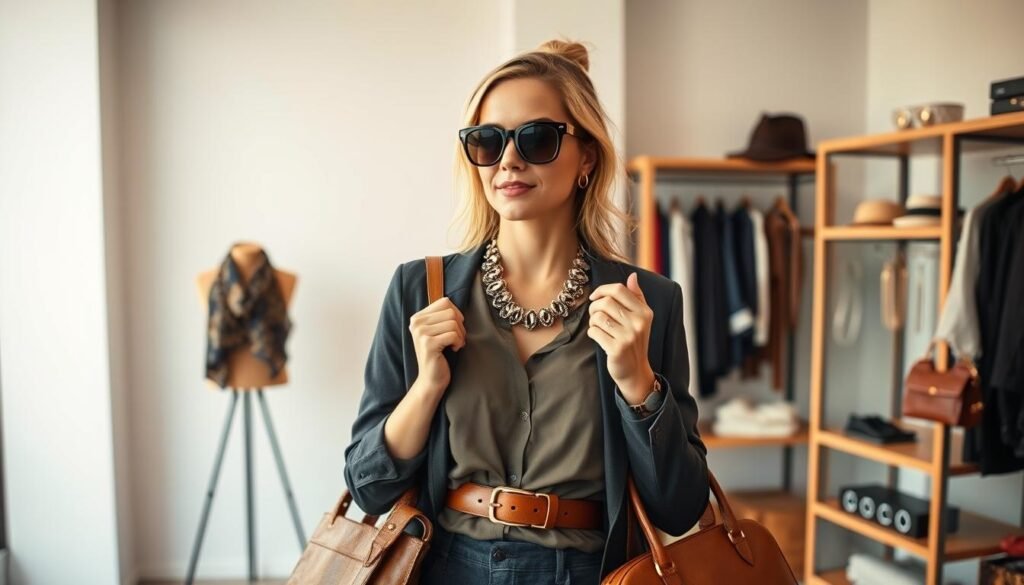
Looking polished is more than just dressing well. It’s about mastering accessory techniques. Stylists know that matching colors is just the start. This accessories buying guide shows you how to create chic looks with ease.
To master accessory coordination, you need to see how they work together. It’s about making combinations that look natural, not forced.
Advanced Layering Techniques for Maximum Impact
The three-layer necklace is key to jewelry styling. Start with a delicate base layer near your neck. Then, add a medium piece for more weight. Finish with a long statement piece to anchor the look.
Mixing metals is all about balance. Use one metal as the main focus and add small touches of another. Different chain styles add texture—try pairing a thin cable chain with a bold curb chain.
Layering bracelets and rings works the same way. Mix widths, textures, and heights for a look that’s intentional and sophisticated.
Avoiding Common Accessory Styling Mistakes
Wearing too many bold pieces is a big mistake. When everything is competing for attention, nothing stands out. Choose one statement piece and let others support it.
Don’t over-match. It makes your look boring and predictable. Instead, coordinate through complementary tones or shared design elements.
| Common Mistake | Why It Fails | Professional Solution | Visual Impact |
|---|---|---|---|
| Matching everything perfectly | Creates boring uniformity | Coordinate through shared elements | Sophisticated harmony |
| Wearing multiple statement pieces | Accessories compete for attention | One statement, supporting pieces | Clear focal point |
| Ignoring proportion balance | Accessories overwhelm or disappear | Match accessory scale to outfit | Balanced composition |
| Neglecting neckline compatibility | Accessories clash with clothing | Choose jewelry that flatters necklines | Seamless integration |
Knowing when you’ve added too much is key. Take off one piece before you leave. Remember, styling tips from pros are about restraint and intention, not quantity.
11. Caring for and Organizing Your Accessory Collection
Keeping your accessories organized and well-cared for opens up new styling options every day. Your fashion accessories are a valuable investment. They deserve careful maintenance and smart storage solutions.
Experts say quality pieces can last forever with the right care. This not only protects your investment but also makes sure each item is easy to find and use every day.
Smart Storage Solutions That Protect Your Investment
Good storage prevents damage and keeps your collection tidy and visible. Jewelry boxes with compartments stop delicate pieces from tangling or scratching.
Hang necklaces one by one to avoid kinks and knots. Use special holders for earrings to prevent losing pairs. Keep bags stuffed with tissue paper to keep their shape.
Closet systems that display scarves and belts make picking them out easier. Use clear containers for small items like hair accessories and pins. Digital apps help you keep track of what you have and inspire new outfits.
| Accessory Type | Storage Method | Key Benefit | Maintenance Frequency |
|---|---|---|---|
| Jewelry | Compartmented boxes | Prevents scratching | Weekly cleaning |
| Leather bags | Dust bags with stuffing | Maintains shape | Monthly conditioning |
| Scarves | Hanging organizers | Prevents wrinkles | Seasonal washing |
| Belts | Belt racks or hooks | Easy visibility | As needed cleaning |
Essential Care Techniques for Different Materials
Different materials need different cleaning methods. Sterling silver should be polished regularly to avoid tarnishing. Leather accessories need conditioning every few months.
Clean fabric accessories as the care labels suggest. Use gentle household items for basic upkeep when you can. Know when to get professional cleaning for valuable items.
These accessory recommendations include regular maintenance routines. Polish metals monthly, switch out seasonal pieces, and check for repairs. Proper care keeps every piece looking great for years to come.
12. Conclusion
Your journey to confident styling begins with the first accessory you pick tomorrow. This guide has equipped you to refresh your wardrobe without a complete overhaul. Professional stylist Sian Clarke says accessorizing becomes easy once you grasp the basics.
Start by applying one styling tip from this guide for a week. This will help you build confidence with each outfit. As you get better, choosing accessories will become second nature.
Quality is more important than quantity. Begin with versatile pieces that fit many outfits and events. These essentials will help you explore more daring styles later.
Your style is unique. This guide offers a framework, but your personal taste is what makes it yours. Listen to your gut as you use these tips in your daily outfits.
Start making changes today by looking at your current accessories. Focus on color, season, or quality. Every small step brings you closer to a more polished look. Your perfect accessory style is waiting for your creativity.

